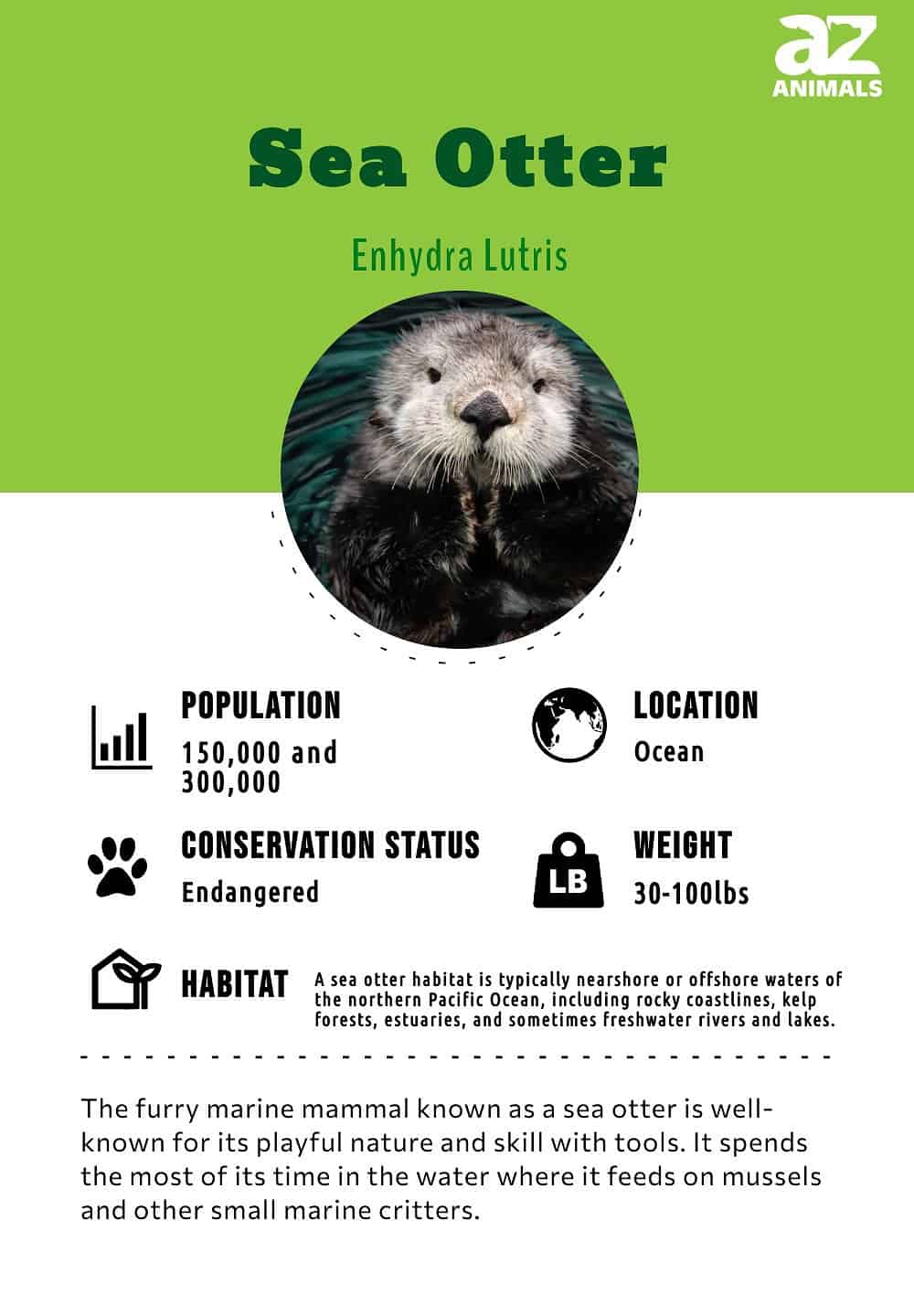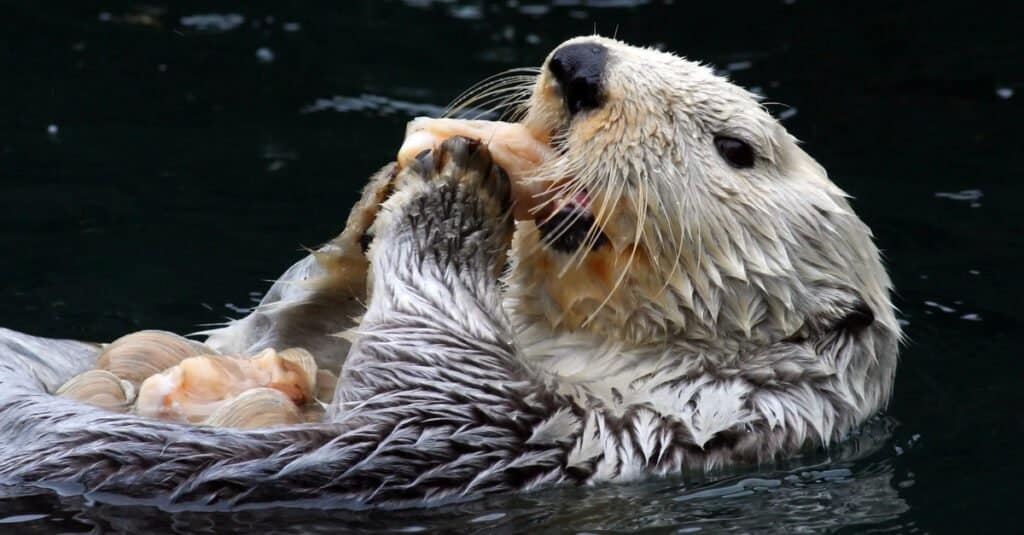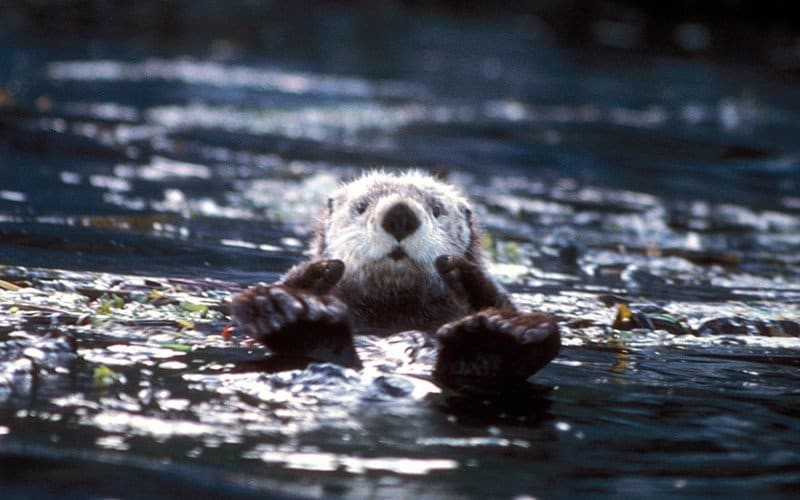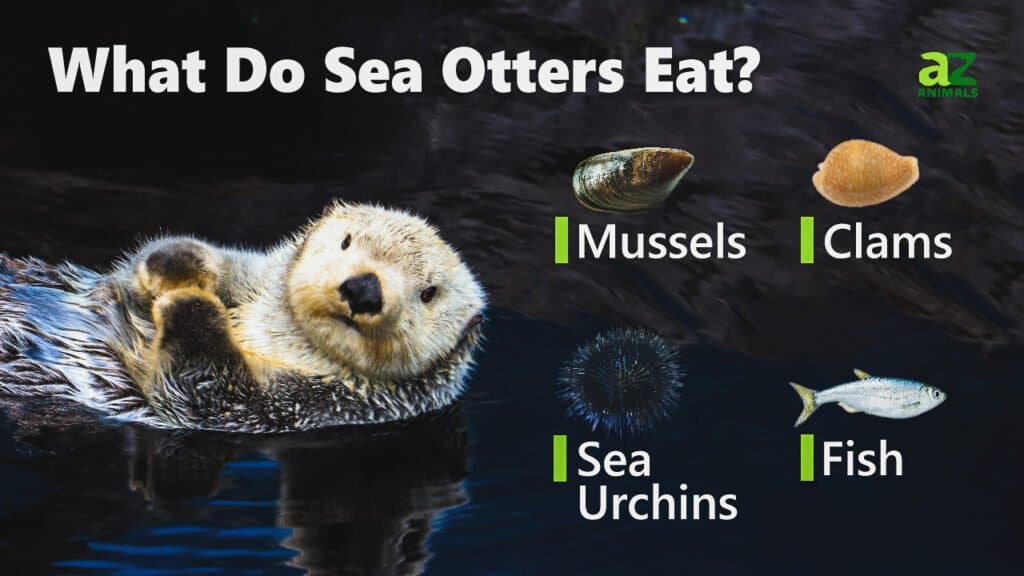Sea Otter
Enhydra Lutris
Eats over 40 different marine species!
Advertisement
Sea Otter Scientific Classification
- Kingdom
- Animalia
- Phylum
- Chordata
- Class
- Mammalia
- Order
- Carnivora
- Family
- Mustelidae
- Genus
- Enhydra
- Scientific Name
- Enhydra Lutris
Read our Complete Guide to Classification of Animals.
Sea Otter Conservation Status
Sea Otter Facts
- Main Prey
- Sea Urchins, Clams, Crabs, Seaweed
- Habitat
- Unpolluted areas close to the shore
- Predators
- Sharks, Humans, Killer Whales
- Diet
- Omnivore
- Average Litter Size
- 1
View all of the Sea Otter images!

The sea otter spends most of its life at sea.
These charming marine mammals are a contrast of extremes. Floating freely on its back, the sea otter seems like the very picture of serenity, but they are quite voracious predators and need to eat a lot to sustain their lifestyle.
They are also very good neighbors and yet highly aggressive when it comes to mates. The sea otters once roamed across large swaths of their Pacific territory, but because their fur is highly desired, they were hunted to the brink of extinction. Population numbers are only partially recovered from their low point.
An Amazing Animal: 3 Sea Otter Facts

The sea otter uses its thick coat to stay warm rather than blubber.
©nvphoto/Shutterstock.com
Here is a list of three amazing sea otter facts:
- Instead of blubber, the sea otter keeps itself warm with its dense coat. With almost a million strands of hair per square inch, the sea otter has the densest fur of any animal in the world.
- The sea otter can stay underwater for about six or seven minutes at a time before it needs to resurface for breath.
- The sea otter has little pockets under each forearm with which it can store food for later.
Scientific Name

The clever otter employs objects such as stones to crack open mollusks and other food.
©Kirsten Wahlquist/Shutterstock.com
The scientific name of the sea otter is Enhydra lutris. Enhydra appears to come from an old Greek term that roughly translates to “in water.” The scientific name Lutris is simply the Latin word for otter. The sea otter is only one of 13 otter species, but it’s also the only living member of its genus. There are currently three recognized subspecies: the Asian sea otter, the northern sea otter, and the southern sea otter. They all occupy the same family, Mustelidae, as the weasels, badgers, wolverines, and minks.
Evolution and Origins
Many freshwater otter fossils originate from the Miocene (5 to 23 million years ago). In the late Miocene and early Pliocene eras, approximately five to seven million years ago, sea otters are thought to have descended from fish-eating, otter-like forebears.
Enhydra lutris, often known as sea otters, first appeared about 2 million years ago, probably somewhere in the far North Pacific Rim, close to Japan and Russia.
Sea otters have a variety of adaptations that enable them to live in their harsh sea environment. They have sensitive forepaws with retractable claws that help them groom, locate and catch prey underwater, and utilize tools.
They have long whiskers that let them detect vibrations in murky waters.
Different Types of Sea Otters
Sea otters are only known as one species (Enhydra lutris), although the Northern sea otter has 13 recognised subspecies (Enhydra lutris kenyoni).
The following subspecies are:
- Enhydra lutris kenyoni
- Enhydra lutris nereis
- Enhydra lutris lutris
- Enhydra lutris kodiacensis
- Enhydra lutris nereis ssp. cinereus
- Enhydra lutris ssp. Litoralis
- Enhydra lutris ssp. nikini
- Enhydra lutris ssp. kayi
- Enhydra lutris ssp. nereis kenyoni
- Enhydra lutris ssp. remanei
- Enhydra lutris ssp. yezoensis
- Enhydra lutris ssp. montereyensis
- Enhydra lutris ssp. pusillus
A Beautiful Animal

Because to its long length, short nose, flat tail, and small, beady eyes, the sea otter is simple to recognize.
The sea otter is easy to identify from its long body, short snout, flat tail, and small beady eyes. The hind feet, which have evolved for an aquatic lifestyle, are very flat and fully webbed. Both the nostrils and ears are able to close when the otter dives underwater. This species has two layers of fur: a dark brown undercoat and a long, lightly colored overcoat.
This fur traps air right next to the skin to keep it warm and dry. This fur is shed and replaced gradually over the year instead of all at once. Its size is also surprisingly large. Measuring around 4 feet and up to 90 pounds in size, the sea otter is one of the largest members of its family – though also the smallest marine mammal in North America.
Behavior

If you happen to pass by the otter’s habitat, you will probably observe it in its typical pose: lying comfortably on its back, occasionally tied to a large piece of seaweed, or holding hands with another otter to keep it from floating off.
The sea otter’s social life revolves around a loose organization of single-sex groups known as a pod or raft. Consisting of between 10 and 100 individuals (though sometimes more), the raft provides safety and respite for the otter in between hunting trips.
If you happen to pass by its habitat, you will often see the otter in its default pose, resting calmly on its back, sometimes tethered to large seaweed or holding hands with another otter to prevent it from floating away. Since dense fur is the key to its survival, the sea otter will spend plenty of time grooming the coat into excellent shape with its natural oils. It will work hard to untangle knots, remove loose hairs, and blow air into the fur.
The otter’s tolerance of its neighbors does not necessarily extend to the breeding months when it’s most likely to maintain and police its territory. The male territory often overlaps with the female territory but not with other males. Sea otters usually respect this social arrangement. A firm display of splashing and angry vocalizations is usually sufficient to deter most interlopers. Fighting is relatively rare.
The sea otter spends most of the daytime resting or grooming, but it most actively hunts between the dawn and dusk hours. It swims through the water at speeds of around 5 mph by moving its body up and down in undulating waves. The front limbs are tucked close to the body, while the hind limbs and tail provide all of the control.
The facts suggest that the sea otter is intelligent and clever. Lacking jaw strength, they will leverage their intelligence to crack open hard-shelled prey. While floating on the sea, the otter will place a rock on its stomach and smash the shell against the rock.
The excellent sense of touch, including the sensitive whiskers, is the main means of finding prey underwater. The sense of smell also helps them identify each other. Otters exhibit an array of different screams, growls, whines, snarls, and whistles to communicate. Pups communicate with their mothers by squealing.
The Animal’s Habitat
Each of the three sea otter subspecies has a distinct geographical range in the Pacific. The Asian sea otter occupies a narrow range of land from the Kuril Islands north of Japan to Russia’s Kamchatka Peninsula. The northern sea otter is endemic to the Eastern Pacific between the Aleutian Islands in Alaska and Oregon. The Southern sea otter is native to the coast of California. They are mostly found in temperate or cold coastal waters with plentiful forests of giant kelp beds. Shallow water no more than 100 feet deep is the otter’s preferred habitat because it means less time spent diving for food.
The Animal’s Predator and Prey
The sea otter plays an important role in the marine ecosystem by keeping the kelp forests from being overwhelmed by urchins and other prey. The otter, in turn, is an important source of nutrition for many predators higher up the food chain. It’s often referred to as a “keystone species.” Whenever it’s reintroduced into a habitat, the health of the ecosystem often improves.
What do sea otters eat?

The otter’s diet consists of clams, mussels, crabs, squid, octopuses, sea urchins, sea stars, and fish, most of which are hard-shelled and need to be cracked open first. Each individual otter has a favorite food in their diet, so to speak. It often becomes specialized in hunting one type of animal, depending on local food availability and the individual’s skills. Sea otters need to consume around a quarter of their body weight in food every single day to support their high metabolism and maintain a comfortable body temperature. They obtain most of their water from food, but they can also drink seawater as necessary.
What eats the sea otter?
The otter faces numerous predators in both sea and land, so it must always be vigilant for threats. Its greatest enemies are sea lions, killer whales, great white sharks, bears, and coyotes. Bald eagles are also known to prey on young otter pups.
Reproduction, Babies, and Lifespan

Although the sea otter can breed all year round, its breeding season is from spring to fall.
©fred goldstein/Shutterstock.com
The sea otter has the ability to breed all year round, but the most active period is spring to autumn. Males will mate with multiple female partners that inhabit their territory. If they do not have an established territory, then they will venture out with other males in search of suitable mates.
The courtship period is an energetic but short three-day tryst that consists of both playful and aggressive behavior. If the female doesn’t like what the male is offering, then she will reject him by shoving him away. But if the female accepts the mate, then the male will actually latch onto her nose and head with his own jaws, which can lead to visible scarring, and then they’ll copulate for about 15 to 30 minutes.
The female does not necessarily become pregnant immediately. She has the ability to delay the implantation of the egg until more favorable environmental conditions arise and food becomes more abundant. This means the gestation period can last anywhere between four and 12 months. Only a single pup is born at a time. Twins only occur in about 2% of all pregnancies, but even then only one pup will survive the difficult juvenile phase.
For the first five or six months of the pup’s life, the mother is solely responsible for all of its care, while the father provides no assistance. She carries the pup on her belly to nurse it, and when she goes out foraging, she wraps the pup in kelp to prevent it from floating away. When danger is present, she dives underwater with the baby in her mouth.
Sea otters have a relatively long development period. Females only tend to reach sexual maturity at about four years of age, while males take about five or six years. But it may be a few years after that before they finally produce their first litter. The life expectancy of a wild sea otter is around 23 years of age. Many of them end up dying early to predators or environmental contaminants.
Because of the longer development time, females only reproduce every two or three years. This also means there are a lot of males competing for relatively fewer sexually available females every year.
A Recovering Animal Population
The facts from archaeological digs suggest that the dense fur of the sea otter has made it a target of hunters for thousands of years. But it wasn’t until the introduction of large-scale industrial hunting in the 18th and 19th centuries that the sea otter was seriously threatened. The population eventually bottomed out at only 1,000 to 2,000 by the early 20th century.
Thanks to the protection of the 1975 Endangered Species Act and the diligent work of conservationists, sea otter numbers have begun to recover. Current population estimations of Californian sea otters place it at around 3,000, all of which descended from a small population of some 50 sea otters found off the coast of Big Sur in 1938.
Even though laws were put in place to protect it, the sea otter is still considered to be a threatened or endangered species. The greatest threats today are diseases, oil spills, and illegal hunting. It is also prone to drowning once caught in fishing nets. The 1989 Exxon Valdez oil spill had a particularly calamitous effect on the remaining Alaskan populations. By damaging the fur on which the otter relies for survival, the oil spill killed thousands and still affects the otter population decades later.
One of the challenges of sea otter conservation is to expand the range beyond its present limits to sustain consistent growth. Habitat degradation, pollution and contaminants, nutritional deficiencies, diseases, and great white shark attacks have all limited the potential growth of the sea otter population. A massive effort to clean up the oceans, improve the ecosystem, and limit the damage from climate change would go a long way toward improving population numbers.
Animals in the Zoo
The sea otter can be found at the Monterey Bay Aquarium in California, the Georgia Aquarium in Atlanta, the Shedd Aquarium in Chicago, the Seattle Aquarium, the Minnesota Zoo, and the Oregon Zoo. Outside of the United States, both the Vancouver Aquarium in Canada and the Birmingham Aquarium in the UK have sea otters on exhibit.
View all 293 animals that start with SSea Otter FAQs (Frequently Asked Questions)
Are sea otters omnivores?
The sea otter’s diet is actually carnivorous.
What is the difference in a sea otter vs. a river otter?
Sea otters and river otters may look almost identical at first glance, but there are plenty of differences to distinguish them. Sea otters tend to grow about two to three times larger in size. They have a shorter, flatter tail. And they are much more acclimated to life in the water with the fully webbed feet. If you spot an otter around the coasts of Alaska or California, then there’s a good chance it’s a sea otter, but river otters do sometimes venture out that far into bays.
What is a baby sea otter called?
Baby sea otters are almost always called pups.
Where do sea otters live?
Sea otters live along the coasts and kelp beds of California, Alaska, and the Russian Pacific.
Are sea otters friendly?
Sea otters do have a friendly and charismatic personality, but even with good intentions, it is almost never a good idea to approach a sea otter in the wild. They may mistake you for a threat.
What Kingdom do Sea Otters belong to?
Sea Otters belong to the Kingdom Animalia.
What phylum do Sea Otters belong to?
Sea Otters belong to the phylum Chordata.
What class do Sea Otters belong to?
Sea Otters belong to the class Mammalia.
What family do Sea Otters belong to?
Sea Otters belong to the family Mustelidae.
What order do Sea Otters belong to?
Sea Otters belong to the order Carnivora.
What genus do Sea Otters belong to?
Sea Otters belong to the genus Enhydra.
What type of covering do Sea Otters have?
Sea Otters are covered in Fur.
What is the main prey for Sea Otters?
Sea Otters eat sea urchins, clams, crabs, and seaweed.
What are some predators of Sea Otters?
Predators of Sea Otters include sharks, humans, and killer whales.
How many babies do Sea Otters have?
The average number of babies a Sea Otter has is 1.
What is an interesting fact about Sea Otters?
Sea Otters eat over 40 different marine species!
What is the scientific name for the Sea Otter?
The scientific name for the Sea Otter is Enhydra Lutris.
What is the lifespan of a Sea Otter?
Sea Otters can live for 12 to 15 years.
How fast is a Sea Otter?
A Sea Otter can travel at speeds of up to 7 miles per hour.
Thank you for reading! Have some feedback for us? Contact the AZ Animals editorial team.
Sources
- Monterey Bay Aquarium, Available here: https://www.montereybayaquarium.org/animals/animals-a-to-z/sea-otter
- Animal Diversity Web, Available here: https://animaldiversity.org/accounts/Enhydra_lutris/
- Seattle Aquarium, Available here: https://www.seattleaquarium.org/animals/river-otters
- IUCN Redlist, Available here: https://www.iucnredlist.org/species/7750/21939518
- , Available here: https://www.seaotters.com/sea-otter-conservation/

















